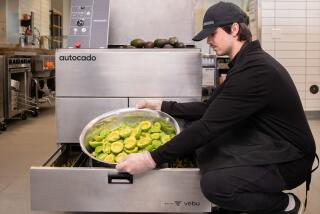Some restaurants serve up iPads for customers to place orders
Pushy waiters and know-it-all sommeliers, step aside. Your days may be numbered.
Tablet computers are starting to take over.
In the last few months, restaurants scattered around the country have installed iPads and other technologies on which customers can place orders and perform additional tasks usually handled by staff.
At Stacked in Torrance, which opened in May, iPads mounted on 60 tables enable patrons to flip through a touch screen to view pizza, burger and salad offerings. Diners can choose entrees and sides, pick out toppings, send their orders to the kitchen and divvy up the bill, all without talking to a staff person.
To pay, customers swipe credit cards through slots built into the iPad holders.
The co-founder of the restaurant, Paul Motenko, said he spent more than a year and $1 million developing the digital ordering regimen. It allowed him to open with a smaller-than-average staff, but he maintained that the hands-on system made customers feel more involved in the process.
“In traditional settings, the communication between guests and the kitchen is so insufficient,” said Motenko, who has opened a second outlet in San Diego and has another planned for Cerritos. “People’s time is valuable. This kind of concept creates a different dynamic.”
Umami Burger is testing another tablet-based self-service ordering system at its casual sit-down restaurant in Los Angeles’ Miracle Mile area. The local chain plans eventually to roll out the devices to its other four locations.
Fast-food eateries, where ordering is normally done at a counter, would seem a natural for the technology. McDonald’s has installed electronic ordering kiosks in 800 of its restaurants in Europe. It has placed one outside its home base in Chicago, though the chain said it had no immediate plans to install the machines across the U.S.
“It’ll have a larger presence in fast food, where a quicker turnaround matters,” analyst Nima Samadi at IBISWorld said about the technology. “In traditional, full-service restaurants, it’s still kind of a gimmick.”
Maybe so, but if it’ll attract customers, it’s going to be tried.
At Catch restaurant in Santa Monica, patrons can browse through more than 230 wines using tabletop iPads. The wines are searchable by type and varietal, with detailed descriptions of a wine’s grape and, in some cases, a photo of the bottle.
“The iPads give the information that guests really want, as much as they want,” said Simon Sorpresi, director of food and beverage at the Casa del Mar hotel, which houses the restaurant.
A gourmet pizza restaurant in Atlanta, Do at the View, extends the tablet concept into its restrooms, where instead of mirrors, mounted iPads use their built-in cameras and screens to show patrons their images for checking hair or makeup.
“It’s all very futuristic, very ‘Star Trek,’” said co-owner Christian Ruffin. Tablet computers are also used by customers for ordering, and for notifying valet parking when they are getting ready to leave.
“We wanted to do something different,” Ruffin said, “to introduce people to modern.”
There was an earlier, unsuccessful attempt at an electronic ordering system. Nolan Bushnell, a legendary entrepreneur who founded the Atari video game company and Chuck E. Cheese restaurant chain, started uWink that in 2006 opened its first restaurant in Woodland Hills. Diners used touch-screen video terminals at tables to order food, play games and view a variety of entertainment clips.
More uWink restaurants opened in Hollywood, Mountain View, Calif., Florida and Canada. But the company never took off, and as of last year all the restaurants had closed.
Rajat Suri, who founded restaurant tablet maker E la Carte, said that it took a while for hardware and software to catch up with the concept.
“It’s only recently that the technology’s been able to do this kind of thing on a mass scale,” he said.
Suri’s company, which developed the system now in use at Umami Burger and about 100 other restaurants, has raised $5 million from investors, including the founders of Groupon.
But what of the human factor, the interaction with a waiter?
Palos Verdes Estates resident L.J. Diener, 36, who dined at Stacked with her mother and two of her children, didn’t miss it.
“It’s really fast, easy and novel,” said Diener, who used the tablet computer to order a Greek pizza and a customized salad. “You can do it all yourself without having to explain your order.”
Nathan Blonkenfeld, however, was uncomfortable with the concept, even though high tech is his livelihood. He works for Wikia, a San Francisco company that provides a way for interest groups to form Web communities in which they can message and share information.
He’s tried Barbacco in the city’s financial district, where the wine list is on iPads. But when Blonkenfeld, 24, goes out to eat, he likes to leave tech at the office.
“I want that extra human element, to be able to talk to someone,” he said. “A future without servers or bartenders — I’d hate that.
“There’s no computer device out there that knows exactly what you need.”
More to Read
Inside the business of entertainment
The Wide Shot brings you news, analysis and insights on everything from streaming wars to production — and what it all means for the future.
You may occasionally receive promotional content from the Los Angeles Times.











